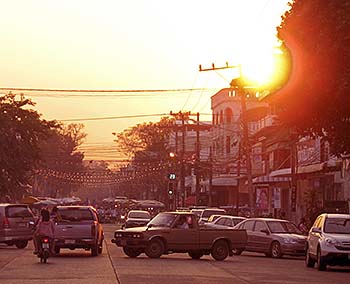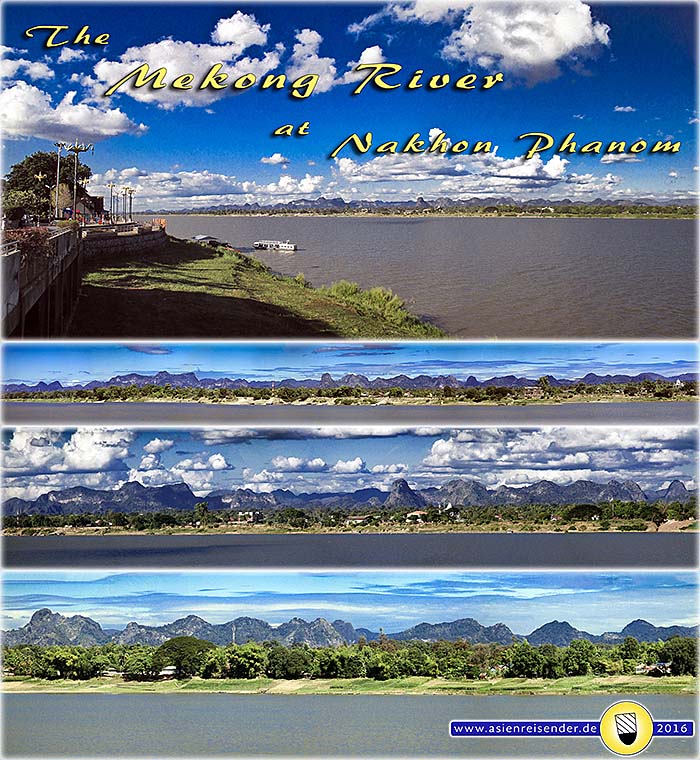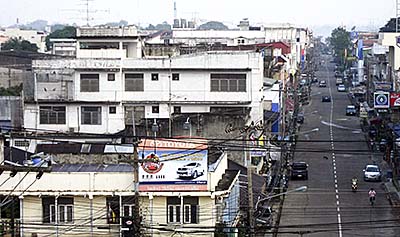Nakhon Phanom
Nakhon Phanom is a Thai city and province in Isan, at the banks of the Mekong River. The name is of Khmer origin, and means Mountain City (Phanom, Phnom is mountain, Nakhon, Nakon is city). Nakhon Phanom is a larger place which is also a trade hub of the region. The symbol of the province shows the chedi of Wat That Phanom.

In the long dry season are frequently bombastic sunsets to watch in town. Image by Asienreisender, 2/2010
Some kilometers north of Nakhon Phanom crosses the '3rd Thai/Laos Friendship Bridge' over the Mekong River, which opened in 2011. Additionally the old ferry service from the pier next to the immigration office is still running between Nakhon Phanom and Thakhek.
On the left side of the Mekong River lies Thakhek, a smaller Laotian place. Many people from Laos come into the border cities along the Mekong in Isan in the search for job. Unfortunately do the Laotians in the service sector not always good. Laotians are widely ignorant, dull and loud. The 2015 staff of Riverview Hotel gives a good impression of that mentality.
Import-export trade also flourishes, with many goods from Vietnam. Nakhon Phanom was also a refuge for many Vietnamese in the Indochina Wars. Also Ho Chi Minh was one of those who seeked for asylum in Thailand. Slightly outside town is a small Ho Chi Minh Museum at the place where he lived for a time in the late 1920s (1928 to 1931(?); the village is Ban Na Chok, called Ho Chi Minh village, and Ho Chi Minh is called 'lung Ho' by the locals, 'uncle Ho'.
Ho Chi Minh (1890-1969)

Ho Chi Minh is one of about 50 pseudonyms of the leading mind of the Vietnamese independence movement against the French colonial power, the struggle against the Japanese occupation in the Second World War and the American aggression in the Second Indochina War. He was a co-founder of the communist party of Indochina and president of Vietnam from 1945 - 1969. The south Vietnamese city of Saigon was renamed into 'Ho Chi Minh City' in 1976.
The time he spent near Nakhon Phanom as one of several stages of his exile life is not exactly clear, but comprises the late 1920s and possibly the early 1930s. There was over decades a significant Vietnamese exile community in Nakhon Phanom. Images and photocomposition by Asienreisender, 2010, 2016
See also: 'The Ho Chi Minh Museum in Saigon' and 'Ho Chi Minh - An Outline'.
In the American Vietnam War was also an American war airport near Nakhon Phanom, from where the US Airforce flew their terror attacks on the neighbouring countries, killed and ruined millions and poisoned the soil with agent orange. In the late 1960 there was a strong insurgency in Nakhon Phanom Province; it was the heartland of communist insurgency led by Thai, Vietnamese and Laotians in Isan. It came to heavy fightings here. The Thai army led a counterinsurgence war in the region and carried out rescue operations in the areas east of the Mekong. Might be that the case of Dieter Dengler (see: Rescue Dawn) happened here.
Nowadays, the airbase is used by the Thai Airforce.
The Mekong River at Nakhon Phanom

The greatest attraction in town seems to me the view on the mountains behind the Mekong River, what gave the place it's name. Nakhon Phanom (Mountain City) is not situated in a mountain scenery; the mountains in question are some twenty or thirty kilometers east and northeast of town in Laos. They are part of the Annamite Mountain Range. While Nakhon Phanom itself lies in the Mekong valley on the high plains of Isan, shortly behind the grand river a number of parallel mountain ridges run in north-south direction. These limestone mountains form bizarre shapes. Here the mountains grant a magnificent view over kilometers. The view is comparable, if not superior to that what one sees in Vang Vieng or at Krabi on the coast of the Andaman Sea.
Images and photocomposition by Asienreisender, 12/2015, 2016
Streetview

Nakhon Phanom city looks like any other Thai city; it's the same style of naked concrete buildings as anywhere else. This style is typical for Thailand, by the way; in the neighbouring countries the cities are each different in their architecture. That means not that they would be anyhow more human, though. Image by Asienreisender, 2/2010
One can walk several kilometers along the riverbanks in Nakhon Phanom to the north. At two smaller sections the promenade is interrupted and one has to walk along the busy parallel road to the river. However, it's worth to do the walk, for the views are great and usually there is a fresh breeze around the river. At the northern section of the promenade are some very impressive, huge bodhi trees and on the grounds of the the old catholic church stand three huge acacias, being among the largest I have ever seen.
In the later dry season, from February to May, the water level of the Mekong lowers so far that a huge sand bank appears. That's called 'Si Khotrabun Golden Beach' and is counted also as an attraction. Locals go there for having picnic, food stalls open their service and others go for collecting shellfish.
Along the river bank in town, a bit apart from the river, separated by the river's parallel road, lie several larger Thai temples who look pretty colourful and traditional.
Temples of Nakhon Phanom

Walking southwards along the riverbanks one passes over some hundred meters several Thai temple sites. They all look quite splendit with their golden colours. The tall chedi here can not deny it's relatedness with Wat That Phanom or Wat Choeng Chum in Sakhon Nakhon. Images and photocomposition by Asienreisender 2/2010, 12/2015, 2016
Nakhon Phanom Aquarium

One shouldn't forget to mention the well-made, clean aquarium a bit out of the town center. In numerous aquariums one finds a variety of the guys who live in the Mekong River and it's tributaries. Although it represents only a small faction of the fishes in the grand river, many, if not most, are under severe threat. Modernisation is a thoroughly destructive dynamics. Waste water, traffic, the fishing industries, noise pollution, water removal for irrigation purposes are only some destructive impacts on the Mekong River ecosystem. The worst and most deadly impact means the construction of dozends of dams along the main river and it's tributaries.
The aquazoo is not small and has a huge main aquarium in it's center, which has a glass tunnel so that visitors can pass 'through' the aquarium and watch the animals from all sides. It's bigger than the also very attractive aquarium in Roi Et.
As regularly in Thailand, the entrance fees for foreigners are five times as high as they are for Thai People. Images and photocomposition by Asienreisender, 2/2010, 2016
